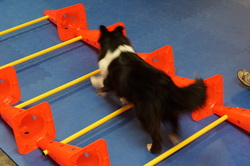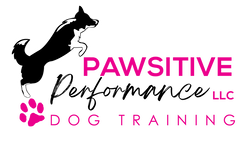 It is important, especially with a performance dog, to understand normal movement and what is not normal for your dog, so you can be proactive about keeping your dog strong and injury free. Many people can see differences in a dog’s gait when watching them move, BUT many cannot or think these things are “normal for their dog”. And then there is a group of us that can obsess over movement. :-) We don’t see dogs anymore, we see strides, and compensations from injury, pain or discomfort, good or poor muscle development and so much more than, “just a dog”. We see movement that causes a dog to drop bars, pop out of weave poles, why a dog is refusing directional cues and simple things like why a dog sits with splayed rear legs or doesn’t want to sit at all. Knowing when to pull your dog from competition before causing further injury is KEY. Catching an injury in the early stages generally means an easier and quicker recovery time depending on severity of injury. Many dogs will WORK through pain and discomfort. Some dogs will shut down from pain but the owner assumes it is behavioral. It is the human’s job to watch out for their dog’s best interest and make sure that their dog is sound before asking them to perform. I often hear, “My dog limps when first coming out of a crate” or “My dog limps a little a day or two after a three day show”. A dog limps due to pain or discomfort. This could simply be due to tight muscles that need to be stretched out, or could be due to an underlying injury especially if this is occurring over and over. For instance, strained muscles often show as an intermittent lameness. A strained muscle requires a rest (NOT crate rest) for 4-6 week with regular icing, massage and anti-inflammatory medication to recover. If left untreated, this will cause your dog to have compensations in other parts of his body that will cause further discomfort and perhaps more injury. Another issue I see often is a dog that stands with a roached back. I understand that many breeds have a slight rounding to their back that is normal for their structure. However, it is important to know what is normal for your breed or your dog and what isn’t. If a dog’s back is un-naturally roached, is a RED FLAG. This dog may not know how to use their core muscles and be in need strengthening, may have digestive issues or might be VERY tight in the low or mid back. Dropping bars, refusing or popping out of weaves, or unable to turn tightly are all signs of tight muscles in a dog’s back or pelvic regions. Again, is important to know what is normal so you can be proactive in helping your dog strengthen and use their body appropriately. Having said all this, watching your dog move can become an obsession. You can start to see things that aren’t there. It is human nature. Video-taping your dog’s movement is a great way to watch and keep track of differences throughout your dog’s life. If you suspect your dog may have a soft tissue or any type of injury is it important to have your dog looked at by a “Qualified Veterinarian” that has experience with performance dog injury. Soft tissue injury is often very hard to diagnose. In addition, what is normal for a pet dog and normal for a performance dog may be different. It is truly important to really SEE how your dog is moving so that you can take note of differences in their weight distribution or gait change. In a performance dog, a small change in gait can have a profound effect on performance. Bobbie Lyons Email: [email protected] Website: http://www.pawsitive-performance.com/schedule.html Comments are closed.
|
AuthorBobbie Lyons, CCFT, KPA CPT Archives
April 2019
Categories |

 RSS Feed
RSS Feed